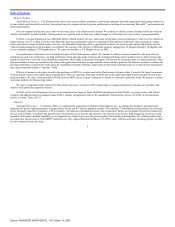AMD 2002 Annual Report Download - page 21
Download and view the complete annual report
Please find page 21 of the 2002 AMD annual report below. You can navigate through the pages in the report by either clicking on the pages listed below, or by using the keyword search tool below to find specific information within the annual report.
Table of Contents
These projections assist us in determining the carrying value of our inventory, and are also used for near-term factory production planning. Inventories on hand in
excess of forecasted demand of generally six months or less, are not valued. In addition, we write off inventories that are considered obsolete. Among other
factors, management considers forecasted demand in relation to the inventory on hand, competitiveness of product offerings, market conditions and product life
cycles when determining obsolescence. Remaining inventory balances are adjusted to approximate the lower of our standard manufacturing cost or market value.
If future demand or market conditions are less favorable than our projections, additional inventory write-downs may be required, and would be reflected in cost
of sales in the period the revision is made. If in any period we are able to sell inventories that were not valued or that had been written off in a previous period,
related revenues would be recorded without any offsetting charge to cost of sales, resulting in a net benefit to our gross margin.
Impairment of Long-Lived Assets. We consider no less frequently than quarterly whether indicators of impairment of long-lived assets are present. If
such indicators are present, we determine whether the sum of the estimated undiscounted cash flows attributable to the assets in question is less than their
carrying value. If less, we recognize an impairment loss based on the excess of the carrying amount of the assets over their respective fair values. Fair value is
determined by discounted future cash flows, appraisals or other methods. If the assets determined to be impaired are to be held and used, we recognize an
impairment loss through a charge to our operating results to the extent the present value of anticipated net cash flows attributable to the asset are less than the
asset’s carrying value, which we depreciate over the remaining estimated useful life of the asset. We may incur impairment losses in future periods if factors
influencing our estimates change.
Restructuring Charges. We record and account for our restructuring activities following formally approved plans that identify the actions and timeline
over which the restructuring activities will occur. Restructuring charges include estimates pertaining to employee severance and fringe benefit costs, facility exit
costs, subleasing assumptions and facility and equipment decommissioning costs resulting from exiting certain facilities. Inherent in these estimates are
judgments about employee relation matters, whether employees might leave earlier than expected, complexities associated with abandoning and
decommissioning facilities, the amount of sublease income we will receive, if any, and the time period necessary to sublease vacant facilities. We review
remaining restructuring accruals on a quarterly basis and adjust these accruals when changes in facts and circumstances suggest actual amounts will differ from
our estimates. Although we do not anticipate significant changes, actual cost may be different than our original or revised estimates.
Deferred Income Taxes. We record a valuation allowance to reduce our net deferred tax assets to the amount that is more likely than not to be realized.
We consider past performance, future taxable income and prudent and feasible tax planning strategies in determining the need for a valuation allowance. In fiscal
2002, we recorded a valuation allowance against all of our deferred tax assets, net of deferred tax liabilities, based on past performance and the likelihood of
realization of our deferred tax assets at this time. If we later determine that it is more likely than not that the net deferred tax assets will be realized, an
appropriate amount of the previously provided valuation allowance will be reversed, resulting in a benefit to our earnings.
Commitments and Contingencies. From time to time we are a defendant or plaintiff in various legal actions, which arise in the normal course of business.
We are also a party to environmental matters, including local, regional, state and federal governed cleanup activities at or near locations where we currently or
have in the past conducted our business. We are also a guarantor of various third-party obligations and commitments. We are required to assess the likelihood of
any adverse judgments or outcomes to these matters as well as potential ranges of probable losses. A determination of the amount of reserves required for these
contingencies, if any, which would be charged to earnings, is made after careful analysis of each individual issue. The required reserves may change in the future
due to new developments in each matter or changes in circumstances, such as a change in settlement strategy. Changes in required reserves could increase or
decrease our earnings in the period the changes are made.
16
Source: ADVANCED MICRO DEVIC, 10-K, March 14, 2003
























